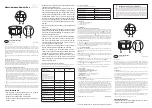
Programming Overview
4–13
In this example, the processor uses the following addresses:
Value:
Base Address:
Offset Value in S:24
Offset Address:
Source
N7:10
10
N7:20
Destination
N7:50
10
N7:60
Addressing File Instructions – Using the File Indicator (#)
The file instructions below manipulate data table files. These files are addressed
with the # sign. They store an offset value in word S:24 (index register), just as with
indexed addressing discussed in the last section.
COP
FLL
BSL
BSR
FFL
FFU
Copy File
Fill File
Bit Shift Left
Bit Shift Right
(FIFO Load)
(FIFO Unload)
LFL
LFU
SQO
SQC
SQL
(LIFO Load)
(LIFO Unload)
Sequencer Output
Sequencer Compare
Sequencer Load
If you are using file instructions and also indexed addressing, make sure that
you monitor and/or load the correct offset value prior to using an indexed
address. Otherwise, unpredictable operation could occur, resulting in possible
personal injury and/or damage to equipment.
Numeric Constants
You can enter numeric constants directly into many of the instructions you program.
The range of values for most instructions is –32,768 t32,767. These values
can be displayed or entered in several radixes. The radixes that can be displayed
are:
•
Integer
•
Binary
•
ASCII
•
Hexadecimal
Programming
efesotomasyon.com - Allen Bradley,Rockwell,plc,servo,drive
















































